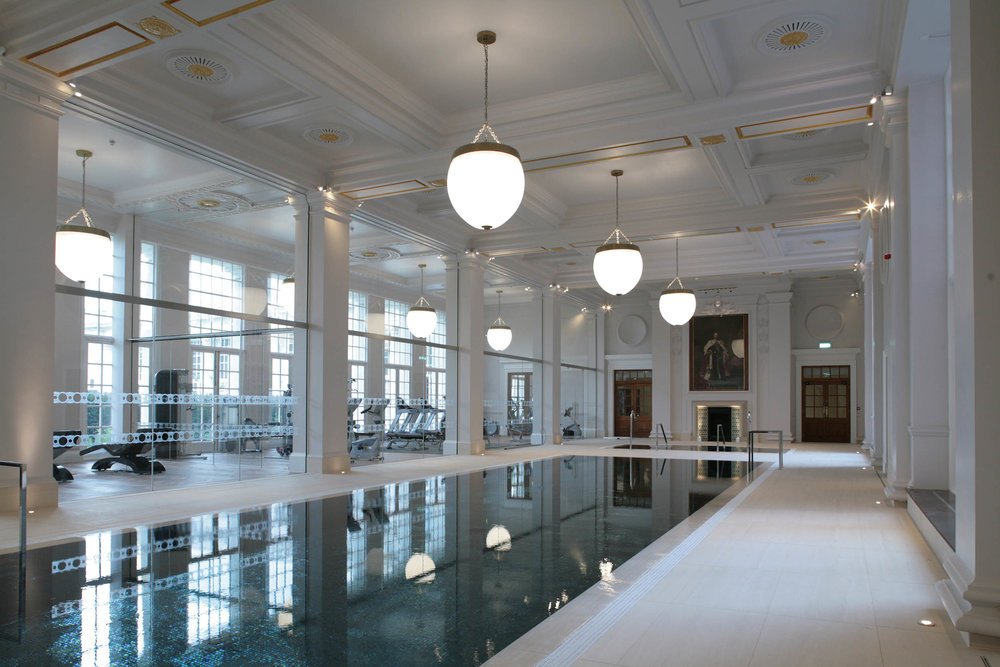Creating bespoke lighting for a luxurious pool room in one of London's most iconic listed buildings
With a reputation for curating our client’s dreams, London’s market-leading prime-specialist team of architects and designers at LA London still relish a design challenge that pushes our concepts to the limits of designed engineering, as Kathryn Archer, Partner at LA London, explains.
The Star & Garter Swimming Pool (King’s Room)
We were delighted to be asked to be the architects involved in the restoration of a beautiful Grade II listed landmark property in London: The Star & Garter in Richmond. This iconic building has incredible views of both the River Thames and Richmond Park. Our client wanted the building’s new communal facilities - a pool, spa, and treatment rooms - to be specified to the highest possible standards. The pool was to be housed in a stunning space that was once a magnificent and palatial dining room known as The King’s Room, named after the portrait of George V that is proudly displayed at one end.
In our original design sketches for the pool room, we had visualised large globe-like lights that reflected the scale, style, and drama of this stunning space. We had to ensure a generous nod to the building’s heritage (as the planner’s Conservation Officer was closely focused on our treatment of this important room), whilst creating a fabulous lighting effect for a state-of-the-art leisure facility. These orb-like lights would need to float seemingly effortlessly across the pool, looking as though they had always been there, lighting the space, whilst also being visually stunning.
Concept sketch
We determined that at their widest the orbs would be more than one metre in diameter, and they would hang nearly two-and-a-half metres down from the ceiling. After extensive research, we concluded that this was not going to be an item that could just be bought off the shelf, especially when it would also need to be suitable for use in a warm, humid swimming pool environment.
We were delighted to be able to collaborate with InLighting, architectural lighting consultants, also based in London. Their designers worked with us to manufacture bespoke pendants from scratch to meet our requirements. Resin was used to form the giant, ribbed orb like shapes, almost like segments of a giant orange. The shape of the mould was made by an artist, and we were able to tweak it to the exact form that we had envisioned. We ensured we were there every step of the way from the design to the final build stage to guarantee that they understood our vision and fulfilled our brief.
The pendants also needed to glow sufficiently brightly to be the primary light source for the space, but we didn’t want to be able to see the LED light source within the light fitting. InLighting were able to show us a number of samples of semi-opaque materials that were then tested to ensure the correct opacity to meet our needs.
Because the pool would be treated with chlorine for hygiene reasons, the light fittings needed to be protected from the potentially corrosive atmosphere. The simple, yet beautifully designed antique brass-effect rings from which the globes hang, also had to be protected from the room’s atmosphere. All the metal components were made from stainless steel and a specialist Bromoco coating was used to ensure protection from the environment of the swimming pool.
Globe lights in manufacture
The electrical supply to the lights was discreetly combined with the elegant hanging chains that attached the magnificent lights to the engineer-designed supports, within the structure above the ceiling. The Ingress Protection (IP) requirement was satisfied by using an integral recessed LED luminaire which was already certified. The LED luminaires were arrayed within the metal top-hat of each orb. The resin material used in the orb not only cleverly diffused the light, creating a uniform glow, but it also absorbed some of the light directly from the source. The structure and connection of the metal top-hat was designed to fit snuggly over the orb’s edge, resulting in minimal dust ingress.
We also had to evaluate the issue of future accessibility to the lights for the purpose of maintenance. The ceiling void was not suitable to take a motorised chain, so the decision was made that accessibility would be via a mobile gantry over the pool. Appropriate specification of the LED lighting source and planned maintenance ensured that this would be a suitably infrequent occurrence.
From a simple sketch at inception to a bespoke light fitting that can float above a pool, here at Lees Associates, we recognise that beauty can be engineered with the right team and a great deal of perseverance.
Click here for more project details and photos.





